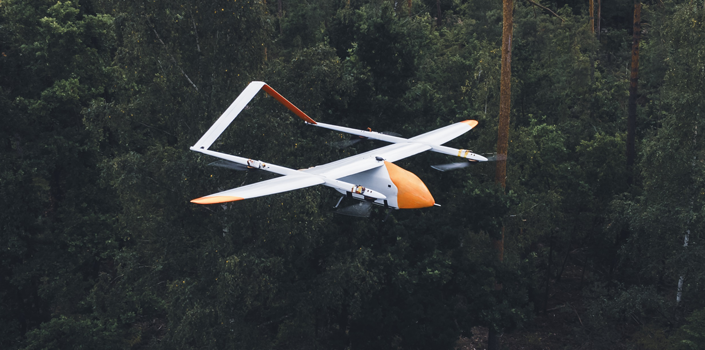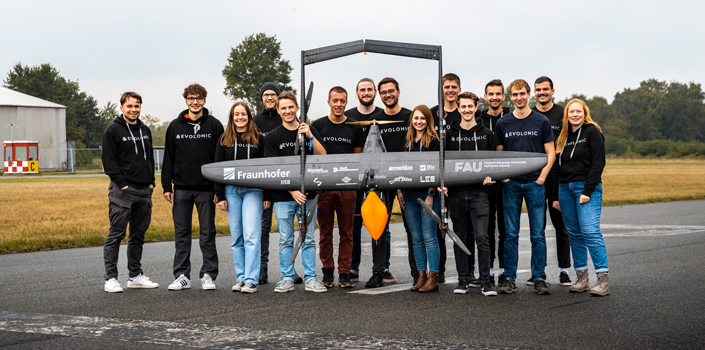Early fire warning by drone

Early detection is crucial in quickly and effectively combating forest fires. In case of danger, drones from Evolonic, equipped with an industrial camera and a lens from SVS-Vistek, provide firefighters with a valuable time advantage.
Global warming has led to an increasing risk of forest fires, particulary in southern European countries, which pose a significant threat to both nature and humans. According to a study by the European Forest Fire Information Systems EFFIS, forest fires are responsible for up to 20% of global CO2 emissions. In 2022, nearly 4,300 hectares of forest were completely burned in Germany, resulting in enormous damage to the economy and the environment. This event also released approximately 739,000 tons of CO2.
An interdisciplinary team of researchers from the Friedrich-Alexander-Universität Erlangen-Nürnberg aims to improve the early detection of forest fires using drones to minimize the impact of such fires. “The earlier a forest fire is identified, the faster the fire department can bring it under control and thus keep the damage to a minimum,” explains Leon Seidel. He is a member of the Evolonic research project team, which has been developing long-range drones and sensor systems for forest fire detection since 2018.
Evolonic has since built and tested four airworthy unmanned aerial vehicle (UAV) prototypes at different stages of development. Currently one of these UAVs is equipped with the maximum detection system and takes off during periods of increased forest fire since summer 2023. “This drone has a range of approximately 100 kilometers and can remain airborne for about 60 minutes”, says Seidel. “During this time, the drone flies on predefined routes that are optimized to cover as large an area of forest as possible.” It then returns to its base station.

A key component of the drone is a forward-facing camera that captures approximately 15 images per second of the area it flies over. An AI software developed by Evolonic, which runs on an onboard computer from Nvidia during the flight, can visually detect and locate smoke sources. “To achieve the shortest possible response times for extinguishing and rescue activities, a web application is available to the fire department control centers and emergency services, which displays the exact position of a suspected fire as well as other relevant information and images,” says Seidel, describing the further process. “This data can be checked directly by an expert in the control center to avoid any false alarms. The data collected in this way can also be used to optimize the AI evaluation at a later stage. Once the source of a fire is confirmed, continuous live images and sensor data from the drone also help the fire department to choose the best approach route and fight the fire on site.”

Machine vision from SVS-Vistek
Seidel notes that the drone’s vision system faced challenges in achieving high image quality and, in particular, a large dynamic range. In addition, the system needed to be small and lightweight to meet performance requirements for the drone's range and flight duration. Compatibility with the onboard Nvidia Jetson computer was also a necessary consideration for the camera.
“For the initial prototypes, we worked with multicopters and drones with less powerful camera and computing hardware,” recalls Seidel. “At that time, cameras with smaller sensors often struggled to detect smoke reliably, especially in challenging lighting conditions, due to their lower dynamic range. Other cameras had issues with real-time control or had a significant latency in image transmission. These factors made the localization of fire scenes significantly more challenging.“
This situation improved after a visit to the PCIM 2023 trade fair in Nuremberg/Germany, where a colleague from Seidel engaged in conversation with Christian Schaarschmidt, DACH Sales Manager at industrial camera manufacturer SVS-Vistek. “I found the idea of using drones and vision systems for forest fire detection fascinating and was sure that we had the perfect fit for this purpose in our range of cameras,” says Schaarschmidt.
The suitability of the exo267CU3 USB3 Vision color camera for use on the drone was confirmed in further discussions with SVS-Vistek. The camera boasts an 8.8 megapixel resolution,, an IMX267LQR global shutter CMOS sensor with a pixel size of 3.45 x 3.45 µm from Sony, and compact housing dimensions of 50 x 50 x 43 mm, weighing only 138 grams. It meets all the requirements for the drone. The frame rate requirement was also no problem for the exo267CU3: it can grab up to around 32 frames/s. SVS-Vistek provided the complete image acquisition system for Evolonic's most powerful drone, including a special Infinity Focus C-mount lens.

“This combination of camera and lens was the optimal choice for its large sensor and low weight, as well as the good software support, including for ARM64, and easy connection to the Nvidia Jetson,” says Seidel happily. “The drone equipped with this system has resulted in a significantly higher early detection rate of fire sources and smoke compared to previous versions. The quality of the camera system is especially noticeable when using in diverse lighting and temperature conditions, which can vary significantly outdoors.”
From Erlangen to all of Germany
In the summer of 2023, Evolonic's drones were primarily used in Erlangen in Franconia, and in a large forest fire test in Saxony-Anhalt. According to Seidel, the area of application could soon be extended to Bavaria or even the entire Germany: “We estimate the costs for the further development of the system until it is market-ready at around half a million Euros. The drones' future aim is complete autonomy and the ability to predict the spread of fires using recorded data. Our development is currently being examined by the Bavarian state government for use in a large pilot project starting in early2025. We are excited to see whether it will be successful.”

The drone-based concept for fire detection also competes with other methods such as satellites, aerial observers, IoT sensors and stationary cameras. “The big advantage of UAV-based forest fire detection over these technologies is the high localization accuracy and coverage of relatively large areas at low cost,” emphasizes Seidel. “Our drones, equipped with SVS-Vistek cameras and lenses, have a high potential for early identification of potential forest fires. This technology may be used in other areas of Bavaria and perhaps also Germany in the future.”

2. Christian Schaarschmidt: “With our USB3 Vision camera exo267CU3 including matching C-mount lens, we were able to provide the perfect image acquisition system for Evolonic's currently most powerful drone.” (© 1. Evolonic - 2. SVS-Vistek)
About Evolonic:
Evolonic is an interdisciplinary team of researchers from the Friedrich-Alexander-Universität Erlangen-Nürnberg in cooperation with Fraunhofer IISB. As part of a project, the team has been developing long-range drones and sensor systems since 2018 that can be used for the early detection of forest fires, among other things.
Evolonic
TechFak Evolonic Hochschulgruppe
c/o Lehrstuhl für Elektronische Bauelemente
Friedrich-Alexander-University Erlangen-Nuremberg
Cauerstraße 6
91058, Erlangen, Germany
Tel.: +49 9131 761472